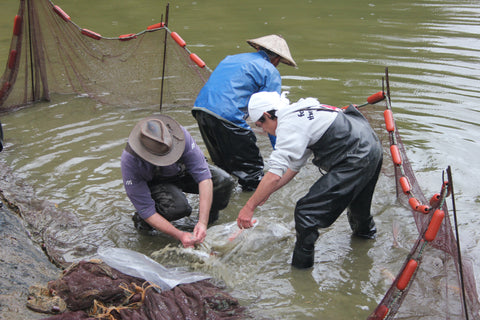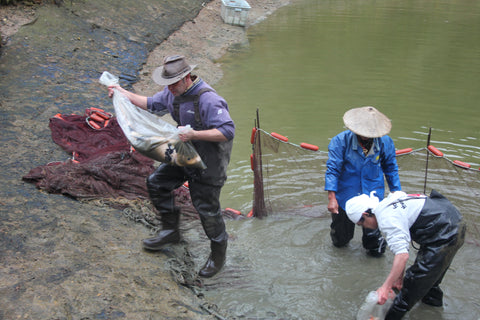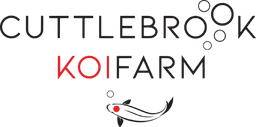When Mark lived in Japan he worked on Yamazaki Koi Farm which was at the time the largest Koi Farm in the country and located in the south of the country. After many years of farming Koi in the UK, he decided that the time was right to return to Japan and to visit the north, specifically the Koi breeders of Niigata. Whilst many dealers host buying trips to Japan, and Mark could easily have gone along on one of these, we felt that it wasn’t the sort of trip that he needed to do. What he really needed was a study tour with the time to really chat to the breeders and to see their facilities in detail and not just to look at the fish that were for sale.
We weren’t sure how this could be achieved, and it would have been unrealistic to expect a Koi dealer to give up his time to host such a specific and tailor made tour. It was at this point that Mark met Martin Symonds whilst at the funeral of a mutual friend, Keith Phipps. Martin runs Japan Koi Export with René Villela. Martin offered to provide Mark with exactly the type of study tour that he needed and on 13th November 2011, he flew to Japan and spent the next week visiting as many breeders as possible in Niigata in the company of just Martin and René.
He harvested parent Koi with the Hosokai brothers and discussed the merits of breeding stock with Toshio Sakai at Matsunoske. He also got the opportunity to visit a great many Koi farms in Niigata.
When Mark left for Japan he had several beliefs that he wanted to put to the test. That we’re on the right track and that the things we are trying to improve are the right things. Keen to find out how things might have changed since his last visit, he was also hoping to discover new things and also to find specific breeders with whom we can build a relationship that will allow us to access the type of quality breeding stock that we need to progress. He also wanted to see for himself how our Koi compare to what is generally available in Niigata.
In order to show the breeders of Niigata who Mark is and what we do here at Cuttlebrook Koi Farm, we produced a small booklet which Mark took with him.
This is Mark’s story……
I came back from Japan in 1986 after working at Kamihata’s (Hikari) Koi Farm in Yamazaki-Cho for six months. There I learned the basis of what became Cuttlebrook Koi Farm. After returning to the UK, I was on the train back from London after a job interview with the then “Brit Koi” when I met a young man called Keith Phipps. We got talking and I discovered he was mad on Koi. We became close friends – even best friends – we even bought a house together when we both worked for “Kent Koi”. After I met my now wife and he his, we grew apart and lost contact. Keith made it to Japan in 1988 and became a legend in Niigata. It has been said that he had the best eye on Koi in anyone outside of Japan – and that was the top Japanese Koi breeders talking.
Imagine my shock when I was told last year in 2010 that he had died and his funeral was in October. I was stunned. Of course I went to say goodbye to an old friend with whom I had shared so many adventures at the start of the UK world of Koi. It was there that I met Martin Symonds. We had met several times in the past at shows and at pivotal moments in Koi history. We got chatting and Martin said he would like to visit the farm to drink a toast to Keith and to see what we were doing. When Martin came to Cuttlebrook we didn’t have much time, but after looking around and of course being impressed he said “Mark, you really have to come back to Japan”. Martin offers bespoke tours – large groups, small groups and one to one and he offered to take me around the breeders of Niigata.
Lisa and I talked about the opportunity and decided to go for it. It was the right time and I didn’t have to go with a dealer and take up his valuable selling time to ask probing questions of how and why. What I needed was a study tour with the opportunity to buy one or two brood fish. We had spent a lot of money recently on brood fish. Choice was getting hard and I needed to choose for myself. We had recently bought a few Kohaku and still needed to try them but I wanted to boost and improve other varieties, particularly Asagi and Shusui. (Asagi are new to us and our Shusui are already very good but as a breeder there are always things one would like to improve). Any breeder will always try to improve on what has gone before. I was also interested in improving my knowledge on go-sanke and discovering for myself which breeders were producing traits that I wanted to see in my own fish. Martin set to work sorting out breeders to see and possibly spend time with. This was going to be one hell of a made to measure tour.
The day eventually arrived and I left Heathrow on Remembrance Sunday. It was strange to see the airport at a standstill for 2 minutes. I was nervous. It was 25 years since I was last in Japan. I was a different person back then and I was travelling into unfamiliar territory, or so I thought.
After landing at Narita airport, Martin’s directions were perfect. “Turn right as you go through customs, down escalators to the trains and buy a ticket for Tokyo on the Narita Express”. Sounded simple, and it was.
The trains were amazing. Your ticket has a car and seat number and the platforms have markers to show where your carriage is going to stop. The trains stop to the centimetre. Martin met me at Tokyo and we got on the bullet train to Niigata, specifically Nagaoka. What was nice was that Japan is starting to become non smoking in public places. They are trying hard. So hard that on the platform at Nagaoka there was only one person to be seen as the other travellers were all crammed into a small Perspex box, grey with smoke, puffing away. You wouldn’t need to light up to get a nicotine fix in that box – amazing.
We left the station and headed for Ojiya-shi. On the way we stopped at a breeder’s. He wasn’t in but his wife gave us “melon” (which it wasn’t) but it tasted good. We were also given the obligatory green tea. Memories came flooding back – that taste – ah. It took me back to Yamazaki. As the breeder wasn’t in we went to the hotel. We checked into the New Plaza Hotel and went straight out to get a feel of the place. It was a blur. Everywhere there was a fish house and stories of mud ponds and earthquakes and landslides. The terrain was very steep with twisting winding roads and it seemed that in every dip and dale there were mud ponds and paddy fields. Where it wasn’t flat trees grew wild.
We ended up at Toshio Sakai’s (Matsunoske) farm in the mountains. It was getting dark. I was introduced to Sakai San and pleasantries were exchanged. He was obviously busy so we made our leave and went back to the hotel. By this time it was around 6.00 pm. My body was saying it was around 9.00 am in the morning and I’d only had one hour of sleep on the plane – if you can call it sleep. I was exhausted but determined to stay awake to try to fend off jet lag. Martin asked what food I’d like and I opted for the Japanese experience. He didn’t disappoint. We ate at a tiny place, capable of seating only a few. The food was skewered meats – tongue, beef and pickled vegetables washed down with beer. I eventually hit the sack at 11.30 pm and Martin made me a wager as we parted. He bet that I’d be awake by 3.00 am. He lost – I was wide awake at 3.30 am and couldn’t sleep. Good job I took along a good book.
Dawn looked cold and wet. Great.

I was supposed to be helping the Hosokai brothers harvest their brood fish this morning. It would be a good opportunity to get a close up of the qualities the Japanese breeders look for in their Oyagoi but I didn’t fancy getting cold and wet. Breakfast was Japanese and continental buffet of boiled eggs, rice, cold cooked fish, fish curd salad, pickled vegetables and toast and Jam, washed down with coffee and juice.
As the rain eased Martin and I headed for the Hosokai’s and arrived as it stopped. We were greeted by the brothers and asked if we wanted long boots. Martin told them I needed the long boots – he didn’t need any as he wasn’t getting wet. I was taken round the back and offered a pair of size four waders – I take size ten. There was no way my feet would fit. They talked for a while then there was frenzied activity as they rummaged through old nets, pumps and pipes. At last they wrestled out an old pair of felt soled waders. They were huge – big enough for big foot himself! They came up to my armpits! Apparently an American hobbyist donated them a few years ago. We loaded up the nets and headed off to the mud ponds. The ponds weren’t far away. Up a steep hill, round a few corners and then down a steep gully, off a narrow track. The two trucks headed down to the pond, after a three point turn to make the corner. I donned the massive waders and plodded off in pursuit.

By the time I got there they were already setting out the net.

I was shown my end of the net and then I started to pull it in.


It felt just like home but then as I waded deeper one of the boots filled with water, fortunately it wasn’t too cold and then moments later the other one filled up. Soon I was wet to the knees. (Now I know how our guests feel when they help out on our farm!)

Just like at home, the fish showed themselves just as we pulled the lead line up the bank. They were good sized Koi around 60 – 80 cm. What struck me first were the Asagi, even in the muddy water the skin was amazing.



The process from then was familiar – holding up the nets with road pins pushed in the mud, then carefully scooping the fish into plastic bags and taking them to Hosokai San who stood on the truck and lifted the fish from a bowl into the transport tank.



By the second fish I was in there catching my own and carrying it horizontally to the truck. It was good fun and hard work.

As the fish were put into the bowl I was able to have a good look at the skin and qualities. This is what I was here for after all.






It didn’t take long to load the fish but we could see three Koi sticking their fins up at us so we went for a second pull.

Whilst the others sorted other stuff out I took the initiative and led out the net. By the time I got half way round the others joined in.


We set out the middle of the net and we started the pull. It was hard going. I have poles on the end of my net, which makes things easier, but these guys hook the leads around their boot and drag it with the feet (I haven’t done it like that for 15 years and found it tough going!).


I was glad when we completed the circle and this time I was pulling the floats in. The same process as before and remarkably the same number of fish!! Fortunately we caught them all this time.



After loading the Oyagoi into the trucks we had to clean and load the net.


As we were cleaning the net we asked about the thousands of small fish that were caught in it. We were told that the Koi don’t eat them and they were just a nuisance (I still don’t know what they were). I made it to the top of the hill where Martin had parked his car and started to take off my waders. Hosokai San came to lend a hand or was it to have a good laugh?!



We drove back to base where I expected to be immediately unloading the Oyagoi only to be informed that tea was much more important.

After a good chat we left them unloading the fish and we headed off to the hotel to get me some dry clothes. What a great first morning in Niigata, thanks to Martin and the generosity of Hosokai Koi Farm.

